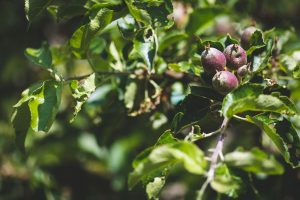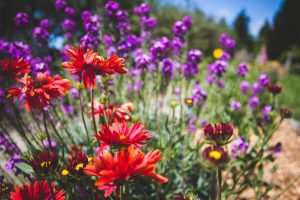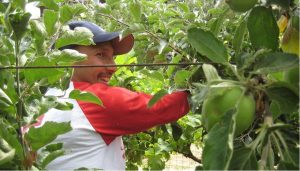Sustaining Ourselves from a Healthy “Urban Orchard”
Summer’s here! Soon many of us will seek shade under the venerable fruit trees that shelter so many of our local backyards. Hiding from the sun’s attention, sipping a backyard blend cider under the branches, take a moment to wonder where these wizened pears, plums and apples that dot the urban tree canopy came from. Most of us didn’t plant them. Strong roots anchored deeply into the earth long before the most recent migration of West Coast bound émigrés started calling this place home.
Fruit trees were first planted on the unceded land of the Coast Salish Territories as early as 1826, when European traders of the Hudson Bay Company transplanted familiar perennial trees from Europe. With its mild climate and fertile soils, fruit trees soon began to define the region, which became known as a legendary fruit-growing center of the British Empire. By the mid-20th century, when innovations in technology and irrigation shifted commercial fruit production into the Okanagan and Similkameen, the slow transformation from rural outpost into a mid-sized city was already underway. Density increased. Rural farms and orchards were carved into private parcels and suburban cul-de-sacs. All the while, aged Bell De Boskoops and Golden Russets stood stoically by, persevering quietly as homes were built, neighbourhoods formed, and a Capital City grew. Through it all, year in and year out, these stately old fruit trees continued their timeless cycle: blossom, bud break, fruit set, harvest and sleep. In Fairfield, the Gorge, Oak Bay and Gordon Head, you can still stand in some backyards and detect the faint suggestion of cultivated rows stretching across adjacent fence lines, reminding of the orchards that came before. Today, an orchard still remains, but now, it’s a truly urban one.
The fact that so many trees survived urbanization is a testament to their communal value. The presence of the urban orchard adds an experience that has mostly vanished from our cities—the experience of growth and harvest. The fast pace of urban life often feels incongruent with the seasonal cycles of vegetative growth, flowering, fruiting and dormancy; yet strolling down a city street, pulling an apple out of a tree and biting into it, directly connects us to the local seasonality of fresh food. The Urban Orchard also plays an important role for the community. Established trees commonly produce more than a single family can consume, and for years, many of Victoria’s oldest fruit trees dropped their annual bounty onto lawns where wasps and deer gorge on loads of homegrown fruit. This neglected bounty became the ground for the amazing community resource that is LifeCycles Fruit Tree Project, which for nearly 20 years has annually connected volunteers and tree owners together to assure the regional abundance of local fruit can be eaten, preserved and shared with the community. Urban trees concentrate a feeling of mutual benefit and responsibility, invoking feelings of generosity and reciprocity both for the land and for each other.
Blessed with such a seasonal bounty, it is sometimes easy to forget about the trees. As soon as we decide to have a tree in the city, we must recognize that the tree becomes a different sort of ecological being that has unique needs. To thrive, fruit trees require yearly care and benefit from pruning, harvesting, and nourishment. Yet, an urban orchard cannot be treated by the same conventions as its rural relatives. Traditional orchards concentrate commercially successful species and varieties in machine accessible, grid-like rows to facilitate the easy harvest of crops, reduce the maintenance of the trees, enhance the efficiency of pollination and control the impact of pests. The goal is to produce large quantities of fruit that can be shipped long distances and stored for long periods of time without losing the aesthetic appeal valued by grocery store patrons. The urban orchard is dispersed widely across the city, with fruit trees scattered across various locations, such as private gardens, parks, and abandoned lots. The vast majority of fruit trees are on private lands. Stewardship of trees is inherited with property ownership, with knowledge about species, variety, pests and tree care rarely passing from resident to resident. Because trees are planted as singles or in small groups, in different styles, each residence requires different tree care needs. Fruit trees benefit greatly from the proximity to other trees. Few fruit trees are self-fertile and most species require at least two different cultivars to get good pollination and fruit set. Often our backyard trees are pollinated from a tree in a nearby yard. Urban fruit trees support a unique ecology. Pest eating birds prefer to nest in higher densities near their food sources, and abundant nectar helps sustain healthy populations of pollinators.
Trees are important features in making a place livable and have community benefits beyond the food they yield. Our urban tree canopy contributes to air and water quality and helps reduce the ‘urban heat island’ effect, among many other beneficial services. The urban orchard plays an important role in the livability of the place as well and is celebrated alongside other species for the beauty of their blossoms and nourishment of their fruits. Fruit trees have long been an integral part of ‘placemaking.’ Fruit trees also create social places: places to be in, and pass through, places to gather together, and places to learn.
Sustaining the urban orchard is not without challenges. The urban tree canopy has been declining in major cities because of increase densification, rapid development. Many large fruit trees, like the fruit bearing standards, are senescing into the later years. Climate change also adds stress to the existing urban orchard. Our region will witness more extreme wind and rainstorms, as well as more prolonged summer droughts. Already new pests are migrating into the area and fungal diseases that were once controlled by cooler winters, are spreading across the south island. The urban orchard will need to be adapted to these challenges. While some species that once fared well may no longer be appropriate, other neglected cultivars may be shown to have genetic resistances that make them thrive. However, shifts in popularity of cultivars have also reduced diversity. Many varieties valued in the past for their exceptional texture, taste, good storability, or beauty continue to be lost as heritage trees are cut down to make way for home construction. As they disappear, so do centuries of knowledge and careful variety selection – along with our ability to discern and appreciate subtle nuances of their flavours. Many aging trees represent heritage cultivars that are increasingly rare, and may represent the last specimens growing in the region or even the world. Hopefully the region’s municipalities can follow the example of Vancouver, who is now working to mitigate overall urban tree canopy loss by strengthening tree protection policies with stricter permits for tree removal and adding city regulations for one-to-one replacements. It may be appropriate to add heritage fruit trees to the list of significant species, so they might enjoy similar protection to Garry Oaks and the giant Sequoias, Cedars, and Chestnuts that line our avenues and parks.
While we can look for support from municipalities to create policies and programs that encourage urban orchard remediation and creation, about 80% of fruit trees are on private land. If we want to ensure that Greater Victoria’s urban orchard ecosystems continues to be a community resource, we need to find ways to steward the trees in our own backyard.
LifeCycles is uniquely positioned to do this. Over 20 years experience harvesting surplus fruit has given us a unique perspective on the needs of the urban orchard. It starts with education. Already Welland Orchard offers opportunities to get hands on learning about orchard practices by attending regular work parties. People can also attend seasonal workshops to learn about pruning, grafting and creating pollinator habitat. LifeCycles is working to understand how we can decolonize our practices and believes that caring for the Urban Orchard in the 21st Century will also require collaboration with indigenous communities and restoration of our region’s native plants and habitats for local animals.
LifeCycles wants to do more. It starts with learning. This year we sent surveys to our list of over 900 tree owners to solicit feedback on the health of their trees and needs for support. Harvest leaders and Tree Assessors will also help us gather more information this season, by assessing the health of the trees as we harvest them. The information gathered will be directly communicated with tree owners, so they can make more informed decisions about tree care and connecting to broader stewardship movement. LifeCycles is also increasing our outreach activities, and will be attending farmer’s markets and public events. We’re also trying to do more around publicly accessible trees, starting by doing tree care assessment training at St. Anne’s.
With their busy urban lifestyle crisscrossed with many competing demands, many tree owners may need help with their tree maintenance. To support this need, this fall LifeCycles will be launching specialized tree care services tailored to the remediation and maintenance of fruit trees in all stages of their lifecycle. If we want ours to be a fruitful city, we will need to change how we view the Urban Orchard. LifeCycles wants to lead the way by changing how the Urban Orchard is stewarded. With your help we can start a movement. If you are interested in learning new ways that you can become a tree steward, keep following our newsletter. And remember, the next time you shelter in the safe embrace of a stately fruit tree, take a moment to appreciate the legacy of the urban orchard and ask yourself… ”how can I become a tree steward?”
by Tim Fryatt


